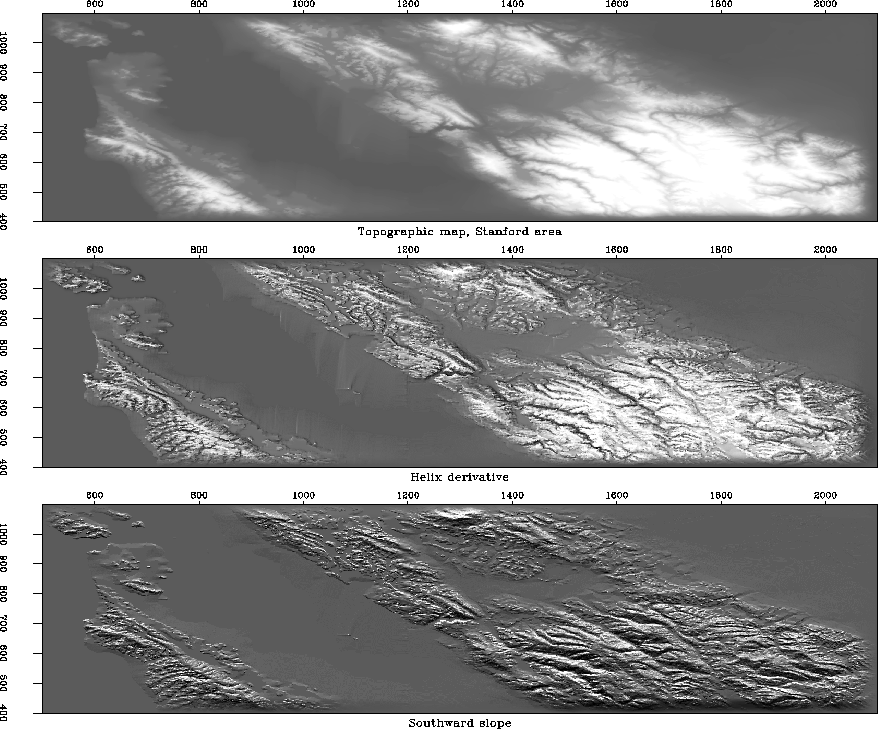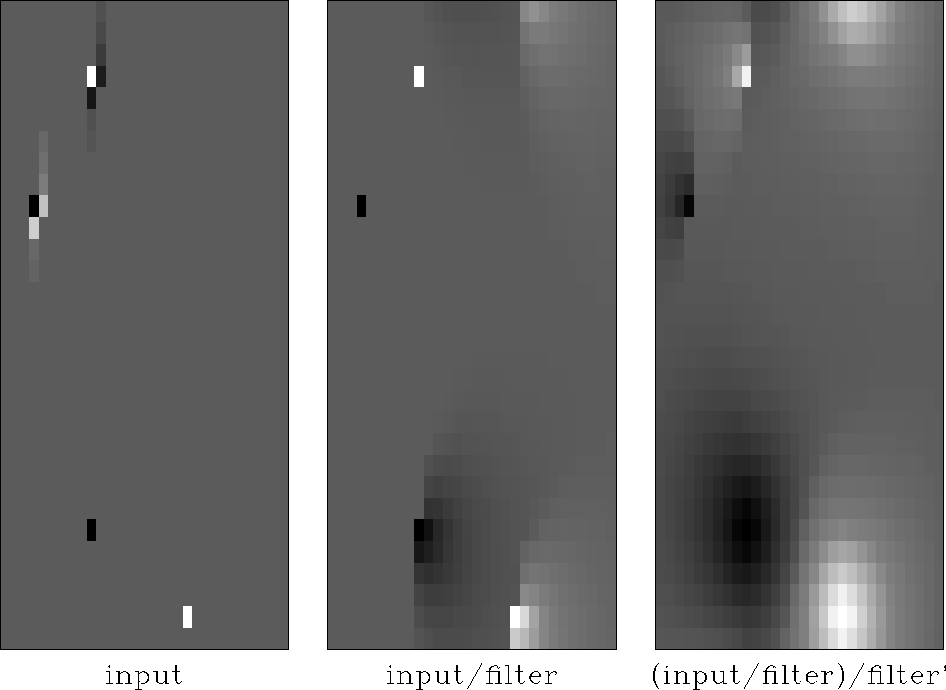| |
(8) |
![[*]](http://sepwww.stanford.edu/latex2html/foot_motif.gif) we discover
how to compute a causal wavelet with this autocorrelation.
I used the ``Kolmogoroff spectral-factorization method''
to find this wavelet
we discover
how to compute a causal wavelet with this autocorrelation.
I used the ``Kolmogoroff spectral-factorization method''
to find this wavelet | |
(9) |
Let the time reversed version of
![]() be denoted
be denoted
![]() .This notation is consistant with an idea from
Chapter
.This notation is consistant with an idea from
Chapter ![[*]](http://sepwww.stanford.edu/latex2html/cross_ref_motif.gif) that the adjoint of a filter matrix
is another filter matrix with a reversed filter.
In engineering it is conventional to use the asterisk symbol
``
that the adjoint of a filter matrix
is another filter matrix with a reversed filter.
In engineering it is conventional to use the asterisk symbol
``![]() '' to denote convolution.
Thus, the idea that the autocorrelation of a
signal
'' to denote convolution.
Thus, the idea that the autocorrelation of a
signal ![]() is a convolution of the
signal
is a convolution of the
signal ![]() with its time reverse (adjoint)
can be written as
with its time reverse (adjoint)
can be written as
![]() .
.
Wind the signal ![]() around a
vertical-axis helix to see its two-dimensional shape
around a
vertical-axis helix to see its two-dimensional shape ![]() :
:
 |
(10) |
| |
(11) |
Since the autocorrelation of ![]() is
is
![]() is a second derivative,
the operator
is a second derivative,
the operator ![]() must be something like a first derivative.
As a geophysicist, I found it natural to compare
the operator
must be something like a first derivative.
As a geophysicist, I found it natural to compare
the operator ![]() with
with ![]() by applying them to a local topographic map.
The result shown in
Figure
by applying them to a local topographic map.
The result shown in
Figure ![[*]](http://sepwww.stanford.edu/latex2html/cross_ref_motif.gif) is that
is that ![]() enhances drainage patterns whereas
enhances drainage patterns whereas
![]() enhances mountain ridges.
enhances mountain ridges.
 |
The operator ![]() has
curious similarities and differences
with the familiar gradient and divergence operators.
In two-dimensional physical space,
the gradient maps one field to two fields
(north slope and east slope).
The factorization of
has
curious similarities and differences
with the familiar gradient and divergence operators.
In two-dimensional physical space,
the gradient maps one field to two fields
(north slope and east slope).
The factorization of ![]() with the helix
gives us the operator
with the helix
gives us the operator ![]() that maps one field to one field.
Being a one-to-one transformation
(unlike gradient and divergence)
the operator
that maps one field to one field.
Being a one-to-one transformation
(unlike gradient and divergence)
the operator ![]() is potentially invertible
by deconvolution (recursive filtering).
is potentially invertible
by deconvolution (recursive filtering).
I have chosen the name![[*]](http://sepwww.stanford.edu/latex2html/foot_motif.gif) ``helix derivative''
or ``helical derivative'' for the operator
``helix derivative''
or ``helical derivative'' for the operator ![]() .A telephone pole has a narrow shadow behind it.
The helix integral (middle frame of Figure
.A telephone pole has a narrow shadow behind it.
The helix integral (middle frame of Figure ![[*]](http://sepwww.stanford.edu/latex2html/cross_ref_motif.gif) )
and the helix derivative (left frame)
show shadows with an angular bandwidth approaching
)
and the helix derivative (left frame)
show shadows with an angular bandwidth approaching ![]() .
.
Our construction makes ![]() have the energy spectrum kx2+ky2,
so the magnitude of the Fourier transform is
have the energy spectrum kx2+ky2,
so the magnitude of the Fourier transform is ![]() .It is a cone
centered and with value zero at the origin.
By contrast, the components of the ordinary gradient
have amplitude responses |kx| and |ky|
that are lines of zero across the
(kx,ky)-plane.
.It is a cone
centered and with value zero at the origin.
By contrast, the components of the ordinary gradient
have amplitude responses |kx| and |ky|
that are lines of zero across the
(kx,ky)-plane.
The rotationally invariant cone in the Fourier domain contrasts sharply with the nonrotationally invariant function shape in (x,y)-space. The difference must arise from the phase spectrum. The factorization (11) is nonunique in that causality associated with the helix mapping can be defined along either x- or y-axes; thus the operator (11) can be rotated or reflected.
This is where the story all comes together.
One-dimensional theory, either the old
Kolmogoroff spectral factorization,
or the new
Wilson-Burg spectral-factorization method
produces not merely a causal wavelet
with the required autocorrelation.
It produces one that is stable in deconvolution.
Using ![]() in one-dimensional polynomial division,
we can solve many formerly difficult problems very rapidly.
Consider the Laplace equation with sources (Poisson's equation).
Polynomial division and its reverse (adjoint) gives us
in one-dimensional polynomial division,
we can solve many formerly difficult problems very rapidly.
Consider the Laplace equation with sources (Poisson's equation).
Polynomial division and its reverse (adjoint) gives us
![]() which means that we have solved
which means that we have solved
![]() by using polynomial division on a helix.
Using the seven coefficients shown,
the cost is fourteen multiplications
(because we need to run both ways) per mesh point.
An example is shown in Figure
by using polynomial division on a helix.
Using the seven coefficients shown,
the cost is fourteen multiplications
(because we need to run both ways) per mesh point.
An example is shown in Figure ![[*]](http://sepwww.stanford.edu/latex2html/cross_ref_motif.gif) .
.
 |
Figure ![[*]](http://sepwww.stanford.edu/latex2html/cross_ref_motif.gif) contains both the helix derivative and its inverse.
Contrast them to the x- or y-derivatives (doublets) and their inverses
(axis-parallel lines in the (x,y)-plane).
Simple derivatives are highly directional
whereas the helix derivative is only slightly directional
achieving its meagre directionality entirely from its phase spectrum.
contains both the helix derivative and its inverse.
Contrast them to the x- or y-derivatives (doublets) and their inverses
(axis-parallel lines in the (x,y)-plane).
Simple derivatives are highly directional
whereas the helix derivative is only slightly directional
achieving its meagre directionality entirely from its phase spectrum.
In practice we often require an isotropic filter.
Such a filter is a function of ![]() .It could be represented as a sum of helix derivatives to integer powers.
.It could be represented as a sum of helix derivatives to integer powers.